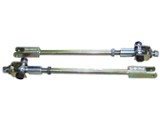How to install 21A1091 HEAVY DUTY ADJUSTABLE TIE RODS
These rods have been produced to improve car stability when cornering and braking, and facilitate easy adjustment of castor angle. Manufactured from a high grade material in a much bigger diameter, they are less susceptible to bending than the standard items.
The standard castor angle is 3° + ½°. This will change when the car is raised or lowered, and when adjustable or negative camber bottom arms are used (these tend to increase castor). The adjustability of these tie rods allows accurate and even setting of the castor angle on both sides of the car. This is important for stability in a straight line and driving out of a corner, more so when a limited slip differential is being use and 13" wheel/tyre combinations. The greater the castor angle, the more "self centering" action will be when accelerating.
Adjustment is achieved by screwing the tie rod in or out of the block that bolts to the bottom arm. This can be done without removing the tie rod from the car by slackening the 11/16" nut on the front end of the tie rod, undoing the lock nut that tightens up against the adjuster block, then turning the tie rod with a spanner on the cut outs provided halfway along the shaft to screw in or out of the block. Shortening the rod by screwing the rod into the block increases castor, decreasing it is done by screwing the rod out of the block - lenghtening the rod.
The standard length is 14 5/16" from the front of the locating washer to the nearest edge of the bolt hole in the adjuster block. One full rotation of the rod adjusts the length by 1/16" which equates to a little over ½°. However, the shorter the tie rod is made, the less amount of alteration is achieved. It is not recommended to use more than 5½° of castor, less than 2° will greatly reduce the steerings self centering action. Altering the castor also alters the camber. Increasing castor reduces camber, and vice versa.
NOTE: ALWAYS start with the tie rod set to the standard length, as starting with the rod longer can cause a misleading phenomenon known as "tea trolley" effect, where the bottom ball joint is behind the top one as viewed from the side.








